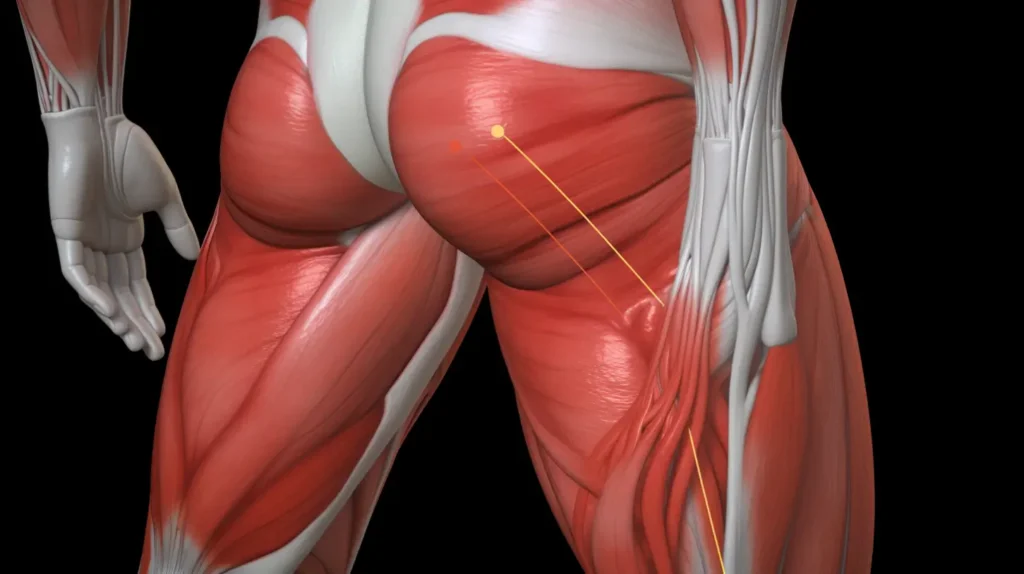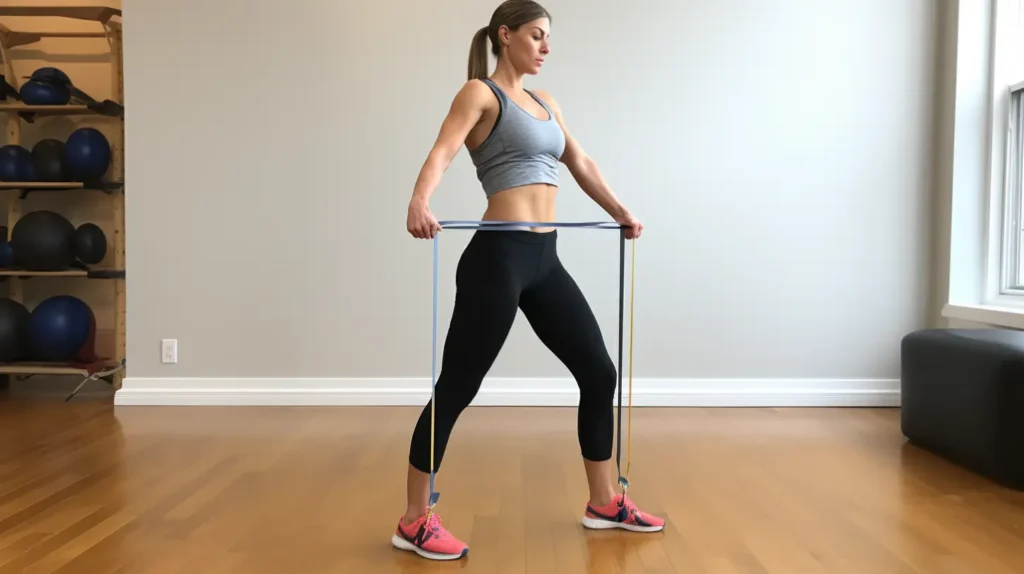Strengthening your abductor muscles is not only beneficial for alleviating pain, correcting poor posture, and addressing knee problems but also plays a pivotal role in boosting your overall athletic performance. By engaging in targeted exercises to fortify these muscles, you not only contribute to a healthier and more pain-free body but also enhance your physical capabilities, promoting improved agility, stability, and strength across various athletic activities.
- The Importance of Hip Abductor Muscles
- Anatomy of Hip Abductor Muscles
- Primary and Secondary Hip Abductors
- Effective Hip Abductor Exercises
- Other Hip Abductor Exercises
- Benefits of Hip Abductor Exercises
- Considerations and Risks
- The Bottom Line
- The Best Abductor Exercises - A Comprehensive Guide
- StrengthLog's Abductor Workout
- Conclusion
- Source Links
- People also ask
- Q: What are the best hip abductor exercises?
- Q: How do hip abduction exercises work to strengthen your hip abductors?
- Q: Why are strengthening exercises for hip abductors important?
- Q: Can hip abduction exercises help prevent hip pain?
- Q: What muscles are targeted in hip abduction exercises?
- Q: How can hip abduction exercises help strengthen the hip abductors and adductors?
- Q: What is the importance of including hip abduction workouts in your fitness routine?
- Q: How can hip abduction exercises benefit those with hip pain or hip flexor issues?
- Q: What are some effective hip abduction exercises that can be done at home?
- Q: Are there specific precautions to keep in mind when performing hip abduction exercises?
The Importance of Hip Abductor Muscles
The hip abductor muscles, including the gluteus medius, gluteus minimus, and tensor fasciae latae, play a crucial role in providing stability and support to the hips. These muscles are responsible for a range of movements, such as walking, running, and jumping. Strengthening the hip abductor muscles is important for maintaining hip stability and overall lower body strength.
Weak hip abductor muscles can lead to various issues, including pain, poor posture, and increased risk of knee injuries. By incorporating exercises that specifically target the hip abductors into your fitness routine, you can enhance your overall hip strength and reduce the risk of injuries.
Strong hip abductor muscles also contribute to better balance and dynamic stability during physical activities. Whether you’re an athlete looking to improve your performance or someone seeking to enhance your overall fitness and daily mobility, strengthening the hip abductor muscles should be a part of your training regimen.
The Role of Hip Abductor Muscles in Hip Stability and Support
The hip abductor muscles serve a crucial role in maintaining hip stability and supporting the lower back and pelvis. These muscles work together to stabilize the pelvis during movement, preventing excessive tilting or rotation. In addition, they help control the movement of the femur, preventing it from collapsing inward or outward, which can lead to alignment issues and increased stress on the hips and knees.
Weak hip abductor muscles can result in compensatory movements and muscle imbalances, leading to poor hip alignment and increased stress on neighboring structures. By strengthening the hip abductor muscles, you can improve hip stability, reduce the risk of injuries, and enhance overall movement control.
Exercises to Strengthen Hip Abductor Muscles
There are various exercises that target the hip abductor muscles and help strengthen them. Some effective exercises include:
- Standing Hip Abduction: Stand with your feet shoulder-width apart and lift one leg out to the side, keeping your toes pointing forward. Lower the leg back down and repeat on the other side.
- Lateral Band Walk: Place a resistance band around your legs, just above the knees. Take small steps to the side, maintaining tension on the band.
- Clamshell Raise: Lie on your side with your knees bent and feet together. Keeping your feet together, lift the top knee while keeping the feet in contact with each other.
By incorporating these exercises into your workout routine, you can effectively target and strengthen your hip abductor muscles, promoting better hip stability, improved movement control, and reduced risk of injuries.
Anatomy of Hip Abductor Muscles
The gluteus medius, gluteus minimus, and tensor fasciae latae are the three main muscles that make up the hip abductor group. These muscles play a crucial role in hip abduction, which is the movement of the leg away from the body. Let’s take a closer look at each of these muscles and their functions:
The Gluteus Medius
The gluteus medius is located on the lateral side of the hip and is one of the major hip abductors. This muscle originates from the ilium, or hip bone, and inserts onto the greater trochanter of the femur. Its primary function is to stabilize the pelvis during gait and other weight-bearing activities, as well as assist in hip abduction and rotation.
The Gluteus Minimus
The gluteus minimus is another important hip abductor muscle that works in conjunction with the gluteus medius. It is situated deep to the gluteus medius and has a similar origin and insertion. The gluteus minimus primarily functions to abduct the hip, as well as medially rotate and stabilize the pelvis.

The Tensor Fasciae Latae
The tensor fasciae latae is a small muscle located on the lateral side of the hip. It originates from the iliac crest, or the upper border of the hip bone, and inserts onto the iliotibial tract. The tensor fasciae latae assists in hip abduction and also plays a role in stabilizing the hip and knee joints.
| Muscle | Origin | Insertion | Function |
|---|---|---|---|
| Gluteus Medius | Ilium | Greater trochanter of femur | Stabilizes pelvis, assists in hip abduction and rotation |
| Gluteus Minimus | Ilium | Greater trochanter of femur | Abducts hip, medially rotates and stabilizes pelvis |
| Tensor Fasciae Latae | Iliac crest | Iliotibial tract | Assists in hip abduction, stabilizes hip and knee joints |
Understanding the anatomy of the hip abductor muscles is key to developing effective workouts that target these muscles and improve overall hip strength and stability.
Primary and Secondary Hip Abductors
The hip abductor muscles can be classified into two categories: primary and secondary. The primary hip abductors are the gluteus medius, gluteus minimus, and tensor fasciae latae. These muscles are primarily responsible for the abduction of the hip joint, moving the leg away from the body. They play a crucial role in stabilizing the pelvis during movement and maintaining proper hip alignment.
On the other hand, the secondary hip abductors assist in hip abduction but have additional roles in the body. The piriformis, sartorius, and gluteus maximus are examples of secondary hip abductors. While these muscles contribute to hip abduction, they also have other functions. The piriformis helps with external rotation of the hip, the sartorius aids in flexing the hip and rotating the leg, and the gluteus maximus extends the hip joint.
Understanding the distinction between primary and secondary hip abductors is important because it highlights the complexity and interplay of muscles involved in hip abduction and overall lower body movement. Together, these muscles work harmoniously to provide stability, mobility, and strength to the hip joint.
Effective Hip Abductor Exercises
To strengthen your hip abductor muscles, incorporate these effective abductor exercises into your workout routine:
1. Standing Hip Abduction
This exercise targets the gluteus medius and minimus muscles, which are essential for hip stability and support. To perform standing hip abduction:
- Stand tall with your feet shoulder-width apart.
- Place your hands on your hips or hold onto a sturdy object for balance.
- Lift one leg out to the side, keeping it straight and parallel to the floor.
- Hold the lifted position for a few seconds, then lower your leg back down.
- Repeat on the other side.
2. Lying Abduction
This exercise targets the tensor fasciae latae and gluteus medius muscles. To perform lying abduction:
- Lie on your side with your legs extended and stacked on top of each other.
- Rest your upper arm in front of you for support.
- Engage your core and lift the top leg up towards the ceiling, keeping it straight.
- Slowly lower the leg back down.
- Switch sides and repeat.
3. Clamshell Raise
The clamshell raise targets the gluteus medius muscle, helping to strengthen the hip abductors. To perform the clamshell raise:
- Lie on your side with your legs bent at a 90-degree angle.
- Rest your head on your lower arm and place your upper hand on your hip.
- Keeping your feet together, lift the top knee up while maintaining contact between your feet.
- Pause at the top of the movement, then lower your knee back down.
- Repeat on the other side.

Incorporate these hip abductor exercises into your workout routine to strengthen your hip muscles, improve stability, and enhance overall mobility. Remember to maintain proper form and listen to your body to avoid any discomfort or injury during exercises.
Other Hip Abductor Exercises
Aside from the mentioned exercises, there are other effective hip abductor workouts that can further strengthen your muscles and improve overall hip stability and mobility. These exercises offer additional variety and options for individuals looking to diversify their fitness routine.
Resistance Band Walking
Resistance band walking is a great exercise to engage your hip abductor muscles. Simply place a resistance band around your ankles or just above your knees and assume a standing position. Take small steps to the side, maintaining tension in the band. This exercise targets the specific muscles responsible for hip abduction, helping to improve strength and stability.
Water Walking
If you prefer low-impact exercises, water walking is an excellent option. This exercise can be done in a pool or any body of water with sufficient depth. Stand in the water with your feet shoulder-width apart and perform walking motions, lifting your legs to the side with each step. Your hip abductor muscles have to work harder due to the additional challenge that the water provides.
By incorporating these additional exercises into your routine, you can target your hip abductor muscles from different angles and intensities, maximizing your overall progress. It’s important to listen to your body and start with proper form, gradually increasing the intensity and duration as you feel comfortable.
Remember, consistency is key when it comes to seeing results. Aim to incorporate these exercises into your weekly workout routine, and you’ll soon experience the many benefits of strong hip abductor muscles, including improved balance, reduced risk of injuries, and enhanced athletic performance.
Benefits of Hip Abductor Exercises
Strengthening your abductor muscles through targeted exercises offers a multitude of benefits, including improved flexibility and a reduced risk of injury. These exercises specifically target the muscles responsible for hip abduction, leading to greater overall strength and stability in the hip area. By incorporating hip abductor exercises into your fitness routine, you can enhance your athletic performance and maintain optimal mobility.
One of the key advantages of hip abductor exercises is the strengthening effect they have on the abductor muscles themselves. As these muscles become stronger, they provide better support to the hips, resulting in improved stability and posture. This can be particularly beneficial for individuals who engage in activities that require lateral movements, such as running or dancing.
In addition to strengthening the muscles, hip abductor exercises also promote flexibility. These exercises work to increase the range of motion of the hip joint, allowing for smoother and more fluid movements. This enhanced flexibility can translate to improved performance in various physical activities, as well as a reduced risk of strains or muscle imbalances.
Regularly performing hip abductor exercises can help reduce the risk of injury, especially in the lower body. By strengthening the abductor muscles, these exercises help to stabilize the hips and prevent excessive strain on the surrounding joints, including the knees. This can be particularly beneficial for individuals recovering from knee injuries or those looking to prevent knee osteoarthritis.
Benefits of Hip Abductor Exercises:
- Strengthen abductor muscles
- Improve flexibility
- Reduce risk of injury
By including hip abductor exercises in your fitness regimen, you can reap these benefits and enhance your overall physical well-being. Remember to always practice proper form and consult with a healthcare professional before starting any new exercise routine, especially if you have underlying health conditions or previous injuries. With consistent effort and the right guidance, hip abductor exercises can contribute to a stronger, more flexible, and injury-free body.
| Benefits of Hip Abductor Exercises | Description |
|---|---|
| Strengthen abductor muscles | Targeted exercises that specifically work the abductor muscles, increasing their strength and providing better support to the hips. |
| Improve flexibility | By increasing the range of motion of the hip joint, hip abductor exercises enhance flexibility and enable smoother movements. |
| Reduce risk of injury | Regularly performing hip abductor exercises helps stabilize the hips and lower body, reducing the risk of strains and injuries. |
Considerations and Risks
When performing hip abductor exercises, it is crucial to maintain proper form to prevent injuries and maximize the effectiveness of the workout. Proper form ensures that you are targeting the correct muscles and minimizing the strain on other areas of the body.
If you experience discomfort or pain during the exercises, it is important to stop immediately and consult a doctor or a qualified fitness professional. Discomfort could be a sign of improper technique or an underlying issue that needs to be addressed. It is always better to err on the side of caution and seek professional advice to avoid further injury.
In addition to focusing on proper form, it is also beneficial to incorporate balancing exercises into your routine. Balancing exercises help improve stability and proprioception, which are essential for functional movements and injury prevention. Examples of balancing exercises include single-leg balances, stability ball exercises, or yoga poses like tree pose.
| Considerations | Risks |
|---|---|
| Focus on proper form | Potential for incorrect technique leading to strain or injury |
| Seek professional guidance if experiencing discomfort | Potential for aggravating existing injuries or underlying conditions |
| Incorporate balancing exercises | Potential for falls or loss of balance |
Remember, the key to a safe and effective workout is to listen to your body and make adjustments as needed. Consulting a fitness professional can provide you with personalized guidance and ensure that you are performing the exercises correctly.
The Bottom Line
Strengthening your hip abductor muscles is of utmost importance for overall fitness and mobility. By incorporating targeted exercises into your routine, you can experience a myriad of benefits and improve your overall well-being. However, it is crucial to pay attention to proper form to maximize the effectiveness of these exercises.
Regularly performing hip abductor exercises not only helps to strengthen these specific muscles but also contributes to improved stability and balance. Strong hip abductors play a vital role in supporting the hip joint and reducing the risk of injuries. Additionally, these exercises can enhance flexibility and mobility, making everyday movements easier and more efficient.
It is important to remember that while hip abductor exercises can be highly beneficial, they should be performed with proper form to avoid strain or injury. Maintaining good alignment and engaging the correct muscles is key to achieving optimal results. If you are unsure about the proper technique, consider consulting a qualified fitness professional for guidance.

In conclusion, prioritizing the strengthening of your hip abductor muscles through targeted exercises can have a significant impact on your overall fitness and well-being. Focus on maintaining proper form, and enjoy the numerous benefits that come with a strong and stable hip complex.
| Benefits of Hip Abductor Exercises |
|---|
| Strengthen hip abductor muscles |
| Improve stability and balance |
| Enhance flexibility and mobility |
| Reduce the risk of injuries |
Quote:
“Don’t underestimate the power of hip abductor exercises. They are the foundation for a strong and stable hip complex, supporting your overall fitness and mobility.”
The Best Abductor Exercises – A Comprehensive Guide
When it comes to strengthening and toning your abductor muscles, incorporating the most effective exercises into your workout routine is essential. In this comprehensive guide, we will explore a variety of exercises that target the abductor muscles and help improve hip strength and stability.
Abductor Muscle Anatomy
Before diving into the exercises, it’s important to understand the anatomy of the abductor muscles. The main abductor muscles responsible for moving the leg away from the body and stabilizing the pelvis during movement include the gluteus medius, gluteus minimus, and tensor fasciae latae. These muscles work together to support hip stability and contribute to overall lower body function.
Now, let’s explore some effective abductor exercises that can help you strengthen these important muscles:
| Exercise | Description |
|---|---|
| Bulgarian Split Squat | A challenging exercise that targets the abductor muscles while also working the quadriceps and glutes. Stand with one foot elevated on a bench or step behind you and lower into a lunge position, keeping your back straight and hips aligned. |
| Lateral Walk With Band | Place a resistance band around your ankles and take small, lateral steps to the side. This exercise engages the abductor muscles and helps improve hip stability. |
| Hip Abduction Machine | This machine specifically targets the abductor muscles. Sit on the machine with your thighs against the pads and push your legs outward against resistance, focusing on squeezing your abductor muscles. |
By incorporating these exercises into your workout routine, you can effectively target and strengthen your abductor muscles, improving hip stability, and overall lower body function. Remember to always perform these exercises with proper form and consult with a fitness professional if needed.
With consistency and dedication, you can achieve stronger, more stable hips, enhancing your overall fitness and mobility.
StrengthLog’s Abductor Workout
Looking to strengthen your hip abductor muscles and improve your overall fitness? Try out StrengthLog’s effective abductor workout routine, which incorporates key exercises such as the Bulgarian split squat, lateral walk with a band, and the hip abduction machine.
The Bulgarian split squat is a challenging exercise that targets the abductor muscles while also engaging the quads, hamstrings, and glutes. To perform this exercise, you’ll need a bench or step. Start by standing with one foot in front of the bench and the other foot extended behind you. Lower your back knee down towards the floor while keeping your front knee aligned with your ankle. Push through your front heel to return to the starting position. Repeat on both sides for a complete workout.
The lateral walk with a band is another effective exercise for targeting the abductor muscles. Place a resistance band around your ankles and stand with your feet hip-width apart. Take a step to the side, keeping tension on the band, and then bring your other foot in to meet it. Continue stepping sideways for a set distance or number of reps. This exercise helps to improve hip stability and strengthen the abductors.

The hip abduction machine is a great tool for isolating and strengthening the abductor muscles. Sit on the machine with your thighs pressed against the pads. Push your legs apart against resistance, squeezing your abductor muscles at the top of the movement. Slowly bring your legs back together and repeat for a complete set. Make sure to adjust the weight and seat position to suit your needs and comfort level.
| Exercise | Description |
|---|---|
| Bulgarian Split Squat | A challenging exercise that targets the abductor muscles, quads, hamstrings, and glutes. Requires a bench or step. |
| Lateral Walk with a Band | An effective exercise that improves hip stability and strengthens the abductor muscles. Requires a resistance band. |
| Hip Abduction Machine | A machine that isolates and strengthens the abductor muscles. Adjust the weight and seat position to suit your needs. |
By incorporating these exercises into your workout routine, you can target and strengthen your abductor muscles, leading to improved hip stability, better overall fitness, and reduced risk of injury. Remember to start with a weight and intensity level that is appropriate for your fitness level, gradually increasing as you become stronger. And as always, consult a fitness professional if you have any concerns or questions about performing these exercises safely and effectively.
Conclusion
Strengthening your abductor muscles through targeted workouts is essential for overall hip strength and stability. Abductor workouts are specifically designed to strengthen these muscles, improving your mobility, preventing injuries, and enhancing your overall athletic performance.
By incorporating effective abductor exercises into your fitness routine, you can experience transformative benefits. Not only will your hips become stronger and more stable, but you’ll also notice improvements in your overall fitness level. Strong abductor muscles contribute to better posture, increased flexibility, and reduced risk of knee problems.
Source Links
- https://steelsupplements.com/blogs/steel-blog/10-best-hip-abductor-exercises-with-video-tutorials
- https://www.dmoose.com/blogs/glute-workouts/how-to-train-your-hip-abductor-muscles
- https://www.strengthlog.com/hip-abductor-muscles-exercises-workout/
People also ask
Q: What are the best hip abductor exercises?
A: Some of the best hip abductor exercises include side lying leg raises, lateral band walks, clamshells, hip thrusts, and cable machine hip abductions.
Q: How do hip abduction exercises work to strengthen your hip abductors?
A: Hip abduction exercises work by targeting the muscles responsible for moving your leg away from your body’s midline, helping to strengthen the hip abductors and improve hip stability.
Q: Why are strengthening exercises for hip abductors important?
A: Strengthening exercises for hip abductors are important to enhance hip stability, improve posture, prevent hip and knee injuries, and support overall lower body strength and function.
Q: Can hip abduction exercises help prevent hip pain?
A: Yes, hip abduction exercises can help prevent hip pain by strengthening the muscles around the hip joint, promoting better alignment and reducing strain on the hips and lower back.
Q: What muscles are targeted in hip abduction exercises?
A: Hip abduction exercises primarily target the hip abductors, including the gluteus medius, gluteus minimus, and tensor fasciae latae, which are crucial for hip stability and proper lower body movement.
Q: How can hip abduction exercises help strengthen the hip abductors and adductors?
A: Hip abduction exercises can help strengthen the hip abductors and adductors by engaging these muscle groups in movements that involve leg straightening and lateral movement, promoting balanced strength and function in the hips and legs.
Q: What is the importance of including hip abduction workouts in your fitness routine?
A: Including hip abduction workouts in your fitness routine is important for targeting and strengthening the smaller muscles around the hips, improving overall lower body stability, and supporting functional movements like walking, running, and squatting.
Q: How can hip abduction exercises benefit those with hip pain or hip flexor issues?
A: Hip abduction exercises can benefit individuals with hip pain or hip flexor issues by helping to rebalance muscle strength around the hips, reducing strain on the hip flexors, and promoting better hip alignment and function.
Q: What are some effective hip abduction exercises that can be done at home?
A: Effective hip abduction exercises that can be done at home include side lying leg raises, clamshells, lateral band walks using resistance bands, and standing hip abduction exercises without equipment.
Q: Are there specific precautions to keep in mind when performing hip abduction exercises?
A: When performing hip abduction exercises, it’s important to maintain proper form, avoid overloading the hips with excessive weight, and listen to your body to prevent any discomfort or strain. Additionally, individuals with existing hip or knee conditions should consult a healthcare professional before starting a new exercise regimen.

